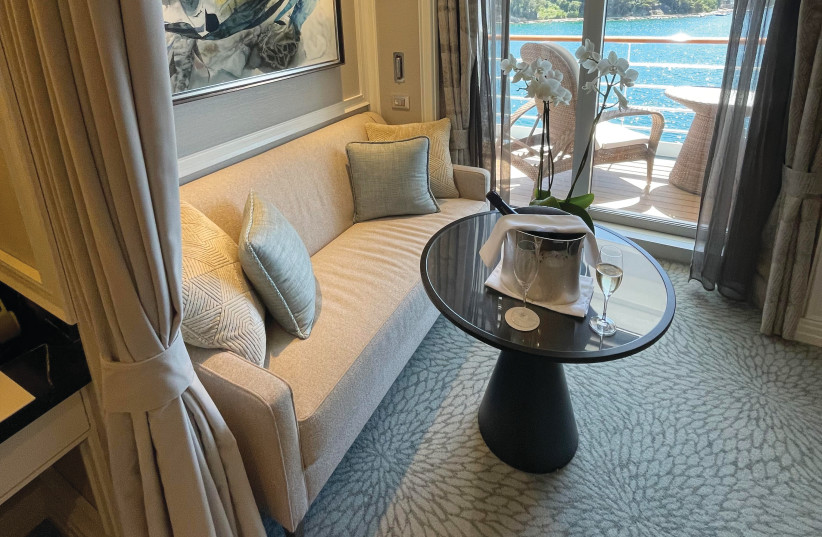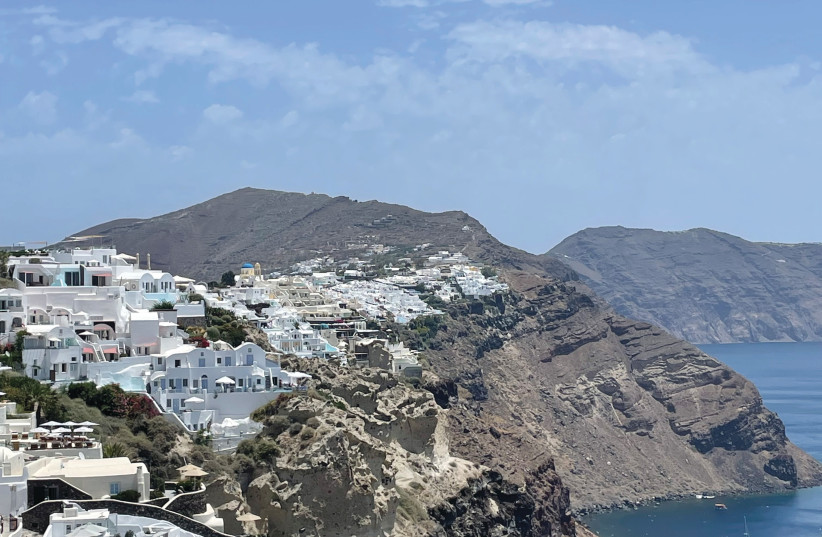People who think they don’t like cruises just haven’t met the right cruise ship yet.
The Regent Seven Seas Grandeur, launched in late 2023, isn’t a sea-going Disneyland with long lines for water slides and go-carts. It’s more like a luxury boutique hotel that happens to float.
The ship accommodates 744 guests (served by 548 crew members), all in balcony suites ranging in size from 29 sq.m. to 413 sq.m. The largest two-bedroom suite has its own pool, sauna, and steam room.
Amenities include a theater, a spa, a fitness center, a casino, a pool, hot tubs, putting greens, boutiques, a well-equipped library, a card room, a cigar lounge, shuffleboard, bocce, and a pickleball court.
Activities include cooking demonstrations, wine tasting, exercise classes, trivia competitions, lectures, karaoke, and crafts.


The ship has several dining venues, from casual to elegant, including French and Asian restaurants. Tables are set with Versace charger plates and Limoges porcelain.
The 89 chefs on board make 23 types of bread every day (but not bagels, which are considered too difficult and are purchased on shore).
Passengers can request kosher meals in advance. The galley has a special locker for kosher utensils and stocks kosher steak, veal, lamb, turkey, and chicken.
Challah and kosher wine are served in the card room on Friday evenings, and passengers are encouraged to lead Shabbat services.
I was part of a group of journalists who boarded the Grandeur in Dubrovnik in early June en route to Istanbul.
Dubrovnik, Croatia
Dubrovnik is familiar to Game of Thrones fans as one of the “King’s Landing” locations.
GoT boosted the city’s already-bustling tourist economy, attracting younger travelers with branded merch, Stark Burgers, and Walk-of-Shame mojitos. The Grandeur included a Thrones walking tour among other shore excursion options.
Although many shops in Dubrovnik display iron throne replicas, a small museum on nearby Lokrum Island (a delightful nature preserve 15 minutes away by boat) has the “real” thing – donated by HBO in thanks for the city’s involvement in the production. If you don’t mind waiting in line, you can have your picture taken on it for free.
To make sure I didn’t miss the boat, I spent the night before embarkation at St. Joseph’s, a 16th-century building lovingly restored as an elegant six-room hotel with Villeroy & Boch bath fixtures and a elaborate breakfast served in the rooms on Wedgewood china.
The friendly and helpful hotel staff arranged for a driver to pick me up at the airport, then met me at the gate of the walled Old City to wheel my suitcase through the maze of narrow cobbled streets to the hotel. A dinner of saffron risotto and grilled vegetables was served just for me in the private dining room.
The hotel is a three-minute walk to Dubrovnik’s Jewish Museum and Synagogue, dating to 1652.
Kotor, Montenegro
The next stop was Kotor, Montenegro – a walled city in a mountainous setting that looks like a fjord but is technically a “ria” (a submerged river canyon).
The shore excursion I picked involved a trip by motor launch to the nearby village of Prcanj, where passengers were welcomed with traditional homemade donuts, peach juice, and grappa and treated to a flute concert in a church decorated with a painting by Tiepolo.
Santorini, Greece
Oia, a village on the Greek island of Santorini, was likely built in the 15th century, with cave homes hollowed out of the soft stone cliffs. Today, its hotel rooms are some of the most expensive in the world.
The village has iconic postcard views of whitewashed buildings topped with azure domes, but you may have to elbow your way through throngs of influencers to reach the most Instagrammable spots.


The steep streets are often jammed with cruise ship passengers jostling past porters hauling suitcases and donkeys hauling tourists.
The Museum of Prehistoric Thera in Firá, the capital and largest city of Santorini, displays artifacts, including stunning murals, from the ancient Minoan settlement of Akrotiri. The settlement (which can also be visited) was buried in volcanic ash by an eruption in the 16th century BCE, preserving it and making it the “Pompeii of Greece” – and the site of the world’s oldest flush toilets.
Another highlight of Firá is the charming and quirky Atlantis Books, where you can find everything from pricey first editions to best-selling paperbacks and lovely journals from a small printer in Athens.
Just across the lane from Atlantis is Volcan on the Rocks – a café bar with the best view in town of the remains of the volcano.
Kusadasi, Turkey
Kusadasi is a touristy city that’s the gateway to archaeological sites like Ephesus, which can become massively over-crowded when multiple cruise ships are in port.
I chose instead to visit three more out-of-the-way sites: Priene, Miletus, and Didyma.
Priene has a well-preserved theater that could seat 6,500, an impressive 4th-century BCE temple of Athena, and the ruins of a synagogue from the first century CE.
Kavala, Greece
The modern city of Kavala is now a busy commercial center with few signs of its history dating back to the 7th century BCE. It has a small but interesting archaeological museum where I was the only visitor on a hot Sunday morning.
A plaque in the museum notes that Jews had lived in the city since the 16th century, but the Jewish community was wiped out during the Shoah.
Near Kavala are the ruins of the Greco-Roman city of Philippi – conquered by (and named for) the father of Alexander the Great.
Istanbul, Turkey
The Grandeur’s last stop was Istanbul, where it overnighted, docked at the city’s ultra-modern cruise port. Two museums, including the terrific Museum of Modern Art designed by star architect Renzo Piano, are part of the port complex.
Istanbul was once an important center of Jewish life and today is home to about 14,000 Jews and 26 active synagogues. The city’s Jewish Museum, in the Galata neighborhood near the port, displays cross-cultural artifacts like a Hanukkiah in the form of a minaret.
Voyaging on the ‘Grandeur’
Fares on the Grandeur vary by length of voyage, cabin size, itinerary, and season. For example, a 10-day trip from Athens to Venice over the High Holy Days in October costs from $8,899 to $56,199 per person.
The writer was the guest of Regent Seven Seas and St. Joseph’s Hotel.
